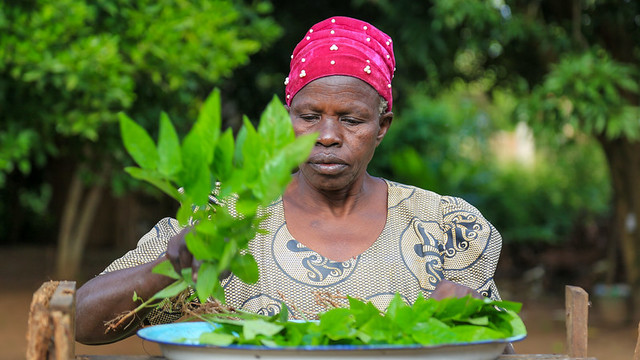Food Systems Summit: implications for global food governance
Last week's Food Systems Summit raised questions about global governance models in a policy area fundamental to everyone’s lives. Lorenzo Cotula argues that, without clear decision-making rules and effective structures to manage power differentials, bringing diverse actors together produces ‘capture’ rather than inclusion.


Food market in Makenene in Mbam-et-Inoubou department, Cameroon (Photo: Jasmine Halki via Flickr, CC BY 2.0)
As United Nations events go, the Food Systems Summit had a strangely synthetic feel. The virtual gathering of heads of state and government – held alongside the UN General Assembly in New York – involved a carefully choreographed mix of glossy videos and read-out statements, facilitated by two presenters in a sleek television-style studio.
Since UN Secretary-General António Guterres announced the initiative in October 2019, several workstreams fed into a pre-summit event in July 2021 and culminated, on 23 September 2021, in the summit itself.
The process illuminated the workings of international diplomacy in a policy area characterised by complex politics, major economic interests and contested evidence, and with far-reaching impacts on lives, livelihoods and culture.
With the politicians now demobilised, observers will pore over the summit’s Statement of Action and the monumental documentation produced throughout the process. But the summit’s real deal lies less in its written words, and more in the governance model that underpinned its preparation and will likely shape its follow-up.
Beneath the gloss
Hunger, malnutrition and unhealthy diets are on the rise. Industrial-scale agriculture is driving deforestation, carbon emissions and biodiversity loss. Land dispossession, worker exploitation and social inequalities are rife in food production and trade. Small-scale farmers feed the world but often struggle to make ends meet. The COVID-19 pandemic has exacerbated longstanding problems and tested the resilience of supply chains.
The summit’s ‘food systems’ framing offered the potential to explore holistic responses – considering food from production to consumption, and its links to ecologies, societies, cultures, economies and politics.
And indeed, aspirational tones pervade the summit’s output. The Statement of Action calls for systemic transformation to end hunger and malnutrition. Political leaders committed to scaling up global efforts. Follow-on steps include national dialogues and international coalitions for action in priority areas such as ‘Nourish All People’ and ‘Advance Equitable Livelihoods’.
But this unifying language belies deep tensions. Though thousands took part in the process, many civil society organisations refused to participate, maintaining that business interests were setting the agenda and that the initiative was bypassing existing UN bodies.
Instead, social movements launched a ‘counter-mobilisation’ to place at centre-stage the rights and voices of small-scale rural producers, Indigenous Peoples, the landless, workers and consumers.
The protests highlighted public concerns that the summit was undermining arrangements for social movements to have a seat at the table, and that lofty statements about shared goals obscured fundamental tensions between approaches and real priorities in the summit’s follow-up.
Food politics – crucial and contested
Food is the foundation of life, culture and identity. Food riots can destabilise governments and securing food supplies is a major political concern; milestones in global food diplomacy were triggered by major food crises.
Food-related activities sustain billions of small-scale farmers, traders and workers. Substantial corporate interests are also at play, such as those of agribusiness, finance and technology companies. While power imbalances favour big industry, vibrant peasant movements have influenced international policy.
Food systems knowledge is deeply divided on the challenges, and how to address them.
These divides underpin radically different visions of food systems and desirable transformations: from high-tech, corporate-led arrangements to boost yields and integrate farmers into global markets; to socially embedded systems that emphasise the agency and innovation of small-scale producers, traders and consumers.
An important question, then, is who sets transformational agendas, and how global policy forums can consider diverse knowledge systems and enable different actors to have a voice.
A careful, fragile equilibrium
The Committee on World Food Security (CFS) has been catering for this complexity. Housed in Rome at the Food and Agriculture Organization of the UN (FAO), CFS facilitates and regulates participation of diverse perspectives – FAO legal texts describe it as the “foremost inclusive international and intergovernmental platform” in food matters.
Within CFS, decision-making rests with states, but businesses and civil society hold participation rights through institutionalised ‘mechanisms’, while a diverse High-Level Panel of Experts distils evidence to inform deliberations.
Though grappling with several challenges, CFS has hosted fraught negotiations and produced influential normative instruments such as the Voluntary Guidelines on Tenure. Its set-up has enabled the Civil Society and Indigenous Peoples’ Mechanism to channel social movements’ voices and to become a vocal player in global food governance.
A governance shift
The Food Systems Summit was the first global food event convened by the UN, rather than its specialised agency, FAO, and the shift from Rome to New York involved more than just geography. The process effectively sidelined CFS, though the statement refers to it as remaining “an essential platform”.
Compared to CFS structures, the summit’s fluid operating modes and coalitions for follow-on action provide less clarity on how different views are to be reconciled. With business lobbying behind the scenes, the lack of clear rules makes it easier for vested interests to shape the agenda, signalling a shift to more business-friendly governance forms.
In an official report to the General Assembly, the UN Special Rapporteur on the Right to Food, Michael Fakhri, found that the pre-summit process “privileged corporate-friendly perspectives” through a multi-stakeholder approach that ignored power imbalances and left states’ roles unclear.
A skewed picture
Governance models influence how problems are conceptualised and addressed. The broad notion of food systems seemed largely reduced to agribusiness-led value chains, with less emphasis placed on diverse food system realities and on cultural and ecological dimensions, and with fundamentally different concepts co-opted in subordinate roles.
The summit’s silences were also significant: on industry promoting unhealthy processed foods, corporate concentration distorting value chains and public policies, contract chains imposing agroindustry terms on rural producers, and large-scale plantations driving pressures on land rights and ecosystems.
The special rapporteur on the Right to Food had called for a strong commitment to human rights, following earlier summits such as the 1974 World Food Conference, the 1996 World Food Summit and its 2002 follow-up. But the right to food featured marginally throughout the process and the statement’s brief references to rights seem oddly out of place, disconnected from foundational concepts and institutions.
Instead, the process primarily emphasised finance, technology and innovation. These can indeed disrupt and catalyse. But they do not necessarily confront deep-seated problems. And depending on who controls the technology, they can exacerbate inequalities.
Centring rights and voice in global governance
The summit fostered public debate about food systems, as reflected in the extensive output of both participants and critics. It also exposed rifts between competing visions of global governance and raised questions about institutional fragmentation, corporate interests in multilateral diplomacy, and agency and democracy in international decision-making.
Without clearly delineated roles, decision-making rules and structures to manage power differentials, bringing diverse actors together produces capture rather than inclusion. In substantive terms, the summit’s technocratic emphasis eluded harder questions about alternative food system models, who controls what, corporate accountability for land, labour and consumer rights abuses, and whose voices are heard in a policy area fundamental to everyone’s lives.
Meanwhile, the activists’ counter-mobilisation and the special rapporteur’s tireless work illustrate how rights struggles occur not just in social and legal arenas but also around the institutional processes that shape narratives, define agendas, catalyse alliances, mobilise resources and, ultimately, frame governance models.
With the summit wrapped up, questions remain about how to authentically transform food systems. Those committed to addressing this challenge should support CFS as the global forum for debating policy strategies. They should also support organisations of food systems actors – from small-scale producers and traders to workers and consumers – in their efforts to regovern territories, markets and livelihoods.
About the author




